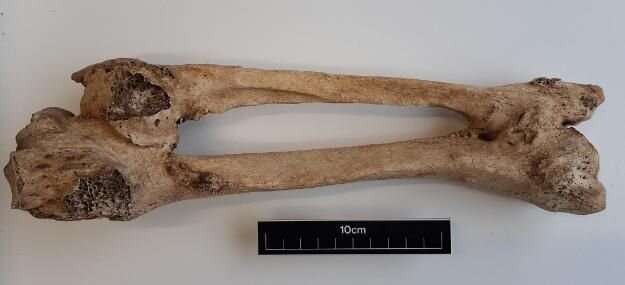The right tibia and fibula, posterior view, of one of the skeletons. Credit: Trinity College Dublin
Two men buried long ago in a medieval graveyard in Co. Donegal had a genetic condition called multiple osteochondromas, which causes benign bone tumors. One of the disease mutations is a new discovery, so this is the first time such information has been unlocked from ancient genomic data.
It seems life was tough in Donegal 1,000 years ago—in a "lost" graveyard at Ballyhanna, where the remains of some 1,300 children, women and men were found during construction of the N15 Bundoran-Ballyshannon bypass, those buried showed high rates of skeletal indicators of stress and ill health and infectious diseases such as tuberculosis.
The land would have been owned by the church at that time and the Gaelic medieval population would have included tenant farmers, laborers, merchants, artisans, clergy and the very poor. The application of ancient DNA analysis to the people of Ballyhanna has enabled us to build upon earlier osteoarchaeological research.
Life was particularly challenging for two men whose bones showed multiple tumors resulting from a genetic disease called multiple osteochondromas. This condition is rare, can be extremely painful and can lead to limb deformity, reduced stature, nerve compression and, in ~ 5% of cases, malignancy.
A major advance in modern medicine is the ability to sequence a patient's genome to find the precise cause of a genetic condition but—until now—this type of comprehensive search had not been done in ancient individuals.
Researchers from Trinity College Dublin and Queen's University Belfast achieved a notable first by analyzing genome sequences from the two affected skeletons and identifying mutations in a gene called EXT1, which is known to be involved in this disease in modern patients. The mutations found were different in the two individuals; one has been identified in some patients today, but the other has not previously been seen in sequencing data.
This study, just published in the European Journal of Human Genetics, thus represents the first time a new disease mutation has been discovered in ancient genomic data.
The disease only occurs in 1 in 50,000 people and when it is found within a modern locality the affected people tend to be related. Here it is surprising that the same rare condition occurred twice in the same parish but resulted from two different mutations. In this case, the lightning of genetic tragedy struck twice.
Iseult Jackson, from Trinity's School of Genetics and Microbiology, the first author of the paper, said, "It was really surprising that these individuals had completely different mutations causing their condition, especially because it's so rare."
Professor Eileen Murphy, Queen's University Belfast, said, "We made several assumptions about these two men when we first realized that they both had suffered from multiple osteochondromas. We assumed they were contemporary but radiocarbon dating showed they were separated by several hundred years. We also assumed they were related but the new aDNA analysis has demonstrated that this is not the case."
Professor Dan Bradley, from Trinity's School of Genetics and Microbiology, said, "Discovery of the mutations that cause serious diseases through application of whole genome sequencing has been a key medical breakthrough in recent years, but this is the first time this has been applied to ancient individuals. The study demonstrates the important contribution that ancient DNA analysis on people from the past can make to understanding conditions that still affect people today."
More information: Iseult Jackson et al, Millennium-old pathogenic Mendelian mutation discovery for multiple osteochondromas from a Gaelic Medieval graveyard, European Journal of Human Genetics (2022). DOI: 10.1038/s41431-022-01219-2
Journal information: European Journal of Human Genetics
Provided by Trinity College Dublin























